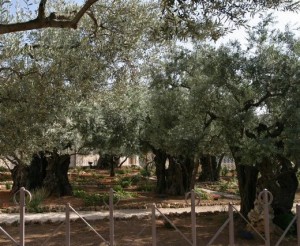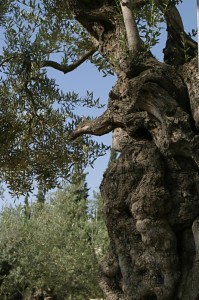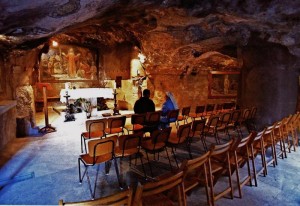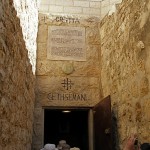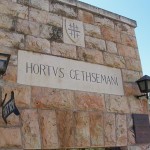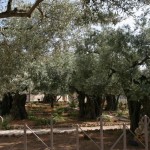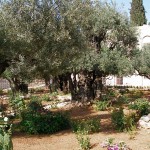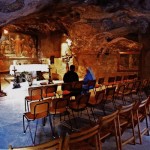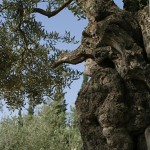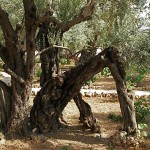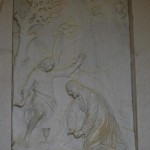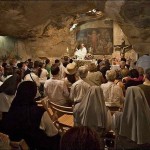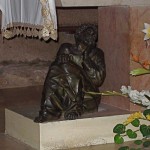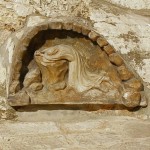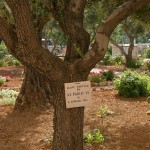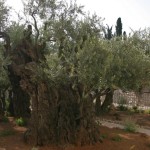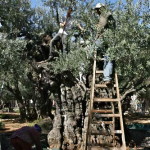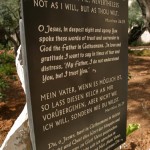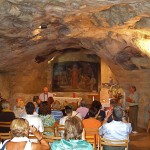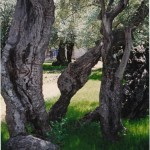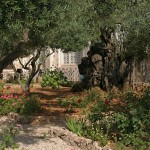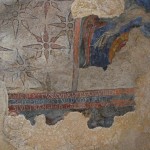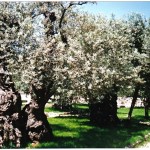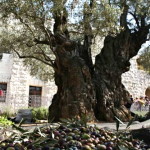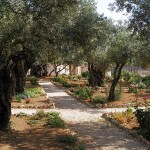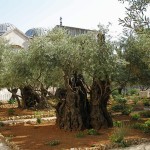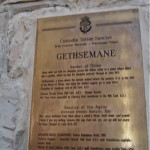Jerusalem
The garden of Gethsemane, near the foot of the Mount of Olives, is named in the New Testament as the place where Jesus went with his disciples to pray the night before he was crucified.
The garden, about 1200 square metres in area, was well known to the disciples as it is close to the natural route from the Temple to the summit of the Mount of Olives and the ridge leading to Bethany.
The name in Hebrew means “oil press”. Oil is still pressed from the fruit of eight ancient and gnarled olive trees that give the garden a timeless character.
Beside the garden is the Church of All Nations, built over the rock on which Jesus is believed to have prayed in agony before he was betrayed by Judas Iscariot and arrested.
About 100 metres north of the church is the Grotto of Gethsemane, where Jesus and his disciples often camped at night. In this natural grotto, it is believed, the disciples slept while Jesus prayed.
Near the grotto is the Tomb of Mary, where a Christian tradition holds that the Mother of Jesus was buried after she “fell asleep” in death.
How old are the trees?
In the garden of Gethsemane, behind a fence of iron tracery with Byzantine motifs, stand the gnarled trunks of eight hoary olive trees. They create a spiritual atmosphere for visitors to the garden of Gethsemane, although the flower beds and paths around them introduce an artificial element.
The trees also generate conjecture about their age. Were they silent witnesses to the Agony of Jesus the night before he died?
Israel has many ancient olive trees. Two in the town of Arraba and five in Deir Hanna have been determined to be over 3000 years old.
The present Gethsemane trees, however, were not standing at the time of Christ. The historian Flavius Josephus reports that all the trees around Jerusalem were cut down by the Romans for their siege equipment before they captured the city in AD 70.
Research reported in 2012 showed that three of the eight ancient trees (the only ones on which it was technically possible to carry out the study) dated from the middle of the 12th century, and all eight originated as cuttings from a single parent tree.
Some of the Gethsemane olives are possibly descendants of those that were in the garden at the time of Christ. This is because when an olive tree is cut down, shoots will come back from the roots to create a new tree.
In 1982 the University of California carried out radiocarbon-dating tests on some root material from Gethsemane. The results indicated that some of the wood could be dated at 2300 years old.
What happens to the fruit from the Gethsemane olive trees? When it is harvested each year, the oil is pressed for Gethsemane’s sanctuary lamps and the pits are used to make rosary beads, given by the Franciscan Custos of the Holy Land to notable pilgrims.
Grotto where the disciples slept
Access to the Grotto of Gethsemane is along a narrow walled passageway leading to the right from the open courtyard in front of the Tomb of Mary.
The natural grotto, about 190 square metres in area, is basically unchanged from the time of Jesus. It is believed to be where the disciples slept while Jesus prayed, and where Jesus was betrayed by Judas and arrested. It may also be the location of Jesus’ night-time meeting with Nicodemus (John 3:1-21).
Over the main altar is a representation of Jesus Praying among the Apostles, while the paintings over the side altars depict the Assumption of the Virgin and the Kiss of Judas.
On a more mundane level, bronze figures beneath the main altar depict two of the sleeping disciples.
The grotto is also known as the Cave of the Olive Press. To the right of the right-hand altar is a hole in the wall. It is just at the right height to hold one end of a wooden beam which, when weighted at the other end, pressed crushed olives piled in loosely woven baskets.
In the 4th century the grotto became a chapel. The floor was paved with white mosaic through which graves were subsequently dug. More than 40 graves, mainly from the 5th to 8th centuries, have been discovered.
The inscriptions on the wall have been interpreted in various ways. The line around the sanctuary seems to mean: “Here [in these representations]: The King sweated blood. Christ the Saviour frequented [this place with his apostles]. My Father, if it is your wish, let this chalice pass from me.”
Related site:
In Scripture:
Jesus prays in Gethsemane: Matthew 26:36-46; Mark 14:32-42; Luke 22:39-46; Mark 32-42
Jesus is arrested: Matthew 26:47-56; Mark 14:43-50; Luke 22:47-53; John 18:1-12
Administered by: Franciscan Custody of the Holy Land
Tel.: 972-2-6266444
Open: Church 8am-noon, 2-6pm (5pm Oct-Mar); Grotto 8.30am-noon, 2.30-5pm (3.40pm Sun and Thur)
- Entering the Grotto of Gethsemane (Seetheholyland.net)
- Garden of Gethsemane sign in Latin (Seetheholyland.net)
- Old olive trees in the Garden of Gethsemane (© Tom Callinan / Seetheholyland.net)
- Garden of Gethsemane beside the Church of All Nations (Seetheholyland.net)
- Grotto of Gethsemane (© Custodia Terrae Sanctae)
- Gnarled trunk in the Garden of Gethsemane (© Tom Callinan / Seetheholyland.net)
- Broken tree in the Garden of Gethsemane (Seetheholyland.net)
- Christ in agony relief at Gethsemane (© Deror Avi)
- Eucharist in the Grotto of Gethsemane (© Custodia Terrae Sanctae)
- Sleeping apostle under the altar in the Grotto of Gethsemane (Seetheholyland.net)
- Wall relief of Jesus in the Garden of Gethsemane (Seetheholyland.net)
- Olive tree planted by Pope Paul VI in 1964 (© Tom Callinan / Seetheholyland.net)
- Stunted olive tree at Gethsemane (© Tom Callinan / Seetheholyland.net)
- Gathering olives at Gethsemane (© Custodia Terrae Sanctae)
- Jesus’ words on a sign in the Garden of Gethsemane (© Tom Callinan / Seetheholyland.net)
- Church service in the Grotto of Gethsemane (Seetheholyland.net)
- Gnarled trees at Gethsemane (Seetheholyland.net)
- Olive trees beside the Church of All Nations (© Tom Callinan / Seetheholyland.net)
- Ancient wall decorations in the Grotto of Gethsemane (Seetheholyland.net)
- Ancient trees at Gethsemane (Seetheholyland.net)
- Crop of olives at Gethsemane (© Custodia Terrae Sanctae)
- Neat paths between the olive trees (Seetheholyland.net)
- Trees beside the Church of All Nations (Seetheholyland.net)
- Entrance notice at Gethsemane (Lyn Gateley)
References
Bar-Am, Aviva: Beyond the Walls: Churches of Jerusalem (Ahva Press, 1998)
Gonen, Rivka: Biblical Holy Places: An illustrated guide (Collier Macmillan, 1987)
Maier, Paul L. (trans.): Josephus: The Essential Writings (Kregel Publications, 1988)
Millgram, Abraham Ezra: Jerusalem Curiosities (Jewish Publication Society, 1990)
Murphy-O’Connor, Jerome: The Holy Land: An Oxford Archaeological Guide from Earliest Times to 1700 (Oxford University Press, 2005)
Dillon, Edward: “The Sanctuaries at Gethsemane”, Holy Land, spring 1998
Storme, Albert: Gethsemane (Franciscan Printing Press, 1970)
Wareham, Norman, and Gill, Jill: Every Pilgrim’s Guide to the Holy Land (Canterbury Press, 1996)
External links

